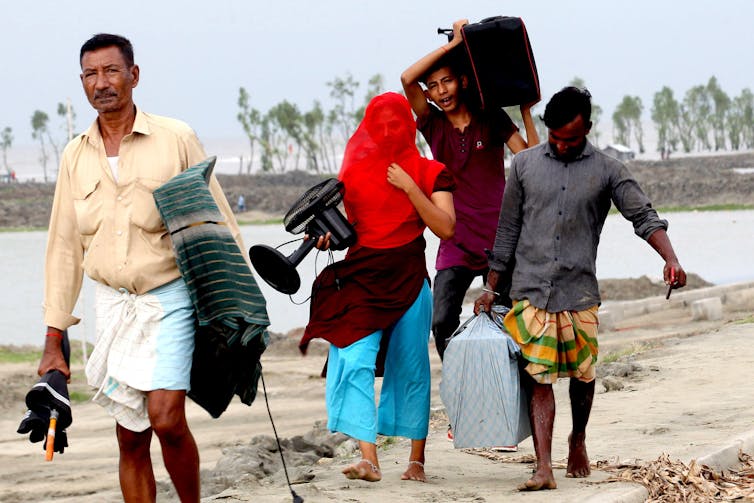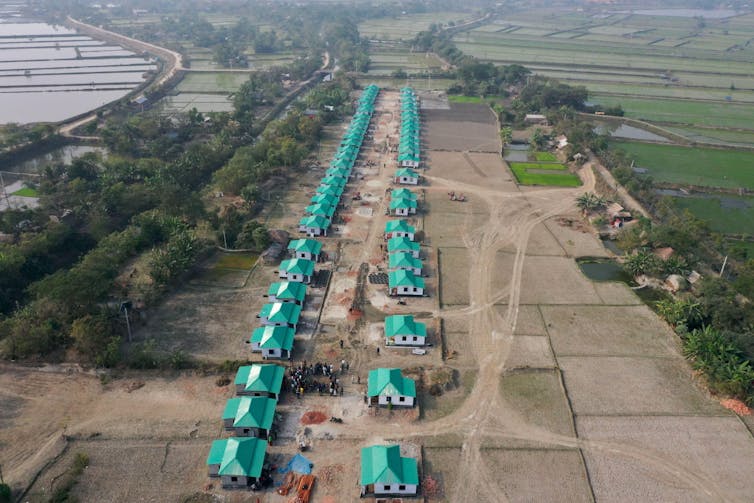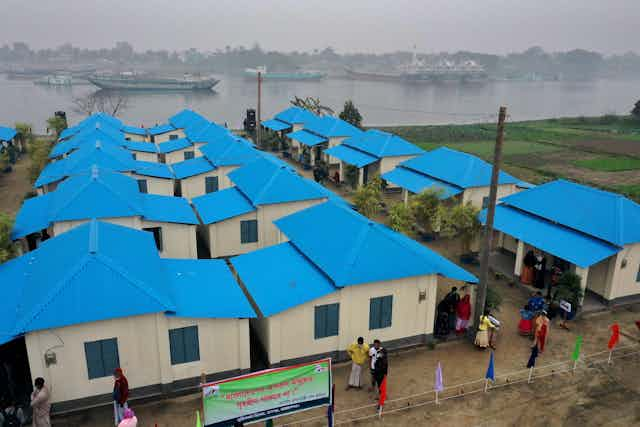Bangladesh is particularly vulnerable to climate extremes. The nation’s topography lays its citizens bare to cyclones, flash floods, erosion and drought – not to mention the significant socio-economic impact these bring.
Agricultural economist GM Monirul Alam showed, in a 2017 study, that with more than 230 tidally active rivers and waterways, 20 of the country’s 64 districts are extremely vulnerable to river-bank erosion. Every year, a total of 8,700 hectares of land is lost, with river channels shifting by as much as 300 meters, displacing 200,000 people as a result.
In 2018, a report for the World Bank estimated that if appropriate mitigation measures are not taken to prepare for climate extremes, as many as 13.3 million people could face displacement within Bangladesh by 2050. With the population expected to reach 220 million by then, that would equate to 6% being made homeless.
Disaster preparedness and relief have always been a key focus for the Bangladeshi government since independence in 1972. The Ashrayan programme, launched in 1997, seeks to build new homes for people who are homeless and landless. It now stands as the biggest project of its kind globally.
By 2022, it had helped 507,244 families resettle at a cost of $355.13 million (£297.98 million).
For my doctoral research, I have studied Bangladesh’s response to climate-related migration, conducting interviews with public officials and other people impacted by the project. I have found that when structures are built at speed, without the necessary support system in place, communities’ vulnerability to the climate crisis only increases.

What is an Ashrayan?
The Ashrayan, which means “to shelter” in Bengali, stems from Prime Minister Sheikh Hasina’s longstanding vision of inclusive development. Hasina, who first came to power in 1996, and was re-elected in 2009 and again in 2014, has repeatedly stated her goal that:
No-one will be left without address or homeless and landless.
An Ashrayan comprises anything from a few dozen barrack houses to several hundred, depending on the land available and the scale of the site. The standard house features two to three rooms, a kitchen, a toilet and a small veranda.
Joint ownership of the land can be awarded in the name of both the wife and husband. Special priority is given to widows, disabled people and the elderly.
The development approach is about much more than just construction. It seeks to implement what development experts and urban planners term “people-centric rehabilitation”. Residents have access to technical training courses and micro-credit programmes, as well as community centres and prayer halls.
Going by numbers of people who have been rehoused – around 554,597 families to date – the success of the programme is evident. However, critics point to the project’s failure to take geographical specificities and cultural nuances into consideration when Ashrayans are built. This, in turn, is hampering efforts to achieve policy objectives.

First, as noted in 2022 by urban planners at Khulna University, local agricultural, ecological and geological knowledge was not being taken into account in the spatial planning process. This oversight in selecting safe sites means residents, and the infrastructure they rely on, are even more vulnerable.
This was made clear when cyclone Amphan hit in 2020. Several barracks were severely damaged.
The following year, in 2021, seven of the 22 homes in a Bogra district Ashrayan, in Rajshahi, collapsed after moderate rains caused subsidence. News reports highlighted the poor construction of the barracks and the fact that they had been built on the sandy soil of a canal bank.
Second, observers have noted inconsistencies in how basic infrastructure is constructed. Without a proper drainage system, untreated sewage and waste is allowed to run off into nearby bodies of water, on which communities depend for water and fishing for a livelihood.
Little consideration has been given to where Ashrayan sites are located in terms of the residents’ chances of employment, access to affordable healthcare and education. When families are unable to make ends meet, children often drop out of school to work in jute mills, shipyards or car garages. Many households have reportedly left their designated barracks because they have been unable to find work.
Most illnesses go untreated simply because the health financing system in the country is underfunded and relies heavily on cash payments. Those who cannot afford to pay thus have little access to healthcare. Moreover, when situated at a remote location, residents lose access to the socio-cultural networks that are key to rebuilding communities.

Administrative bureaucracy is also taking a toll. The process for acquiring a piece of land under the Ashrayan programme and obtaining proof of land ownership is fraught. Relocated families are supposed to be handed the registered deed on the spot. In practice, however, the actual delivery of the relevant certificates and title deeds is taking years.
Barracks are built at speed, and local municipalities, beset with competing priorities, are struggling to keep up. This is evident in the recurring cost and time overruns. Many of the projects are coming in way over budget and are taking longer than predicted.
Successful resettlements across the world have always been more than a reconstruction of what was materially lost. They are about helping communities to rebuild their social fabric on every level: infrastructural, economic and cultural.
When, by contrast, local autonomy, expertise and aspirations are excluded from the planning process and when existing patterns of inequality are not taken into consideration, the foundation on which the resettlement project is built is shaky. It risks further amplifying the vulnerabilities people face.
Bangladesh should be lauded for undertaking the world’s largest resettlement programme. However, without following a systematic approach that combines resilient infrastructure with governmental investment in human and social capital, its citizens will continue to be at the mercy of shifting lands and weather patterns.

